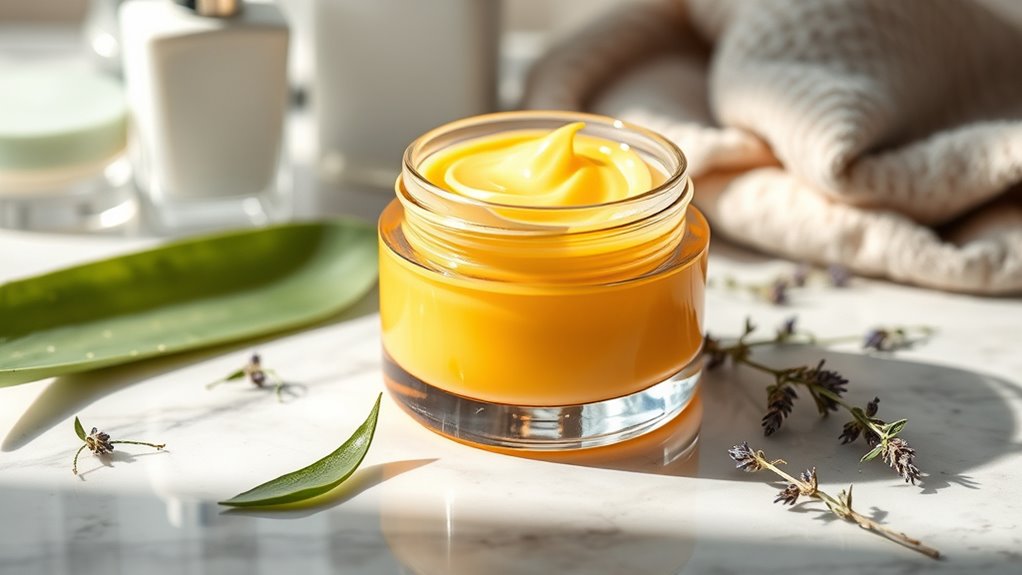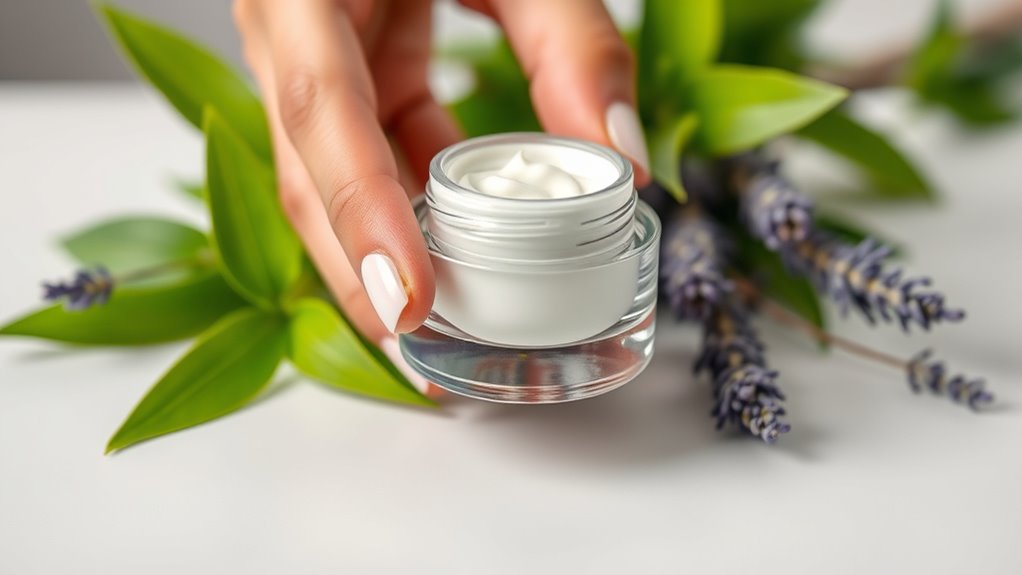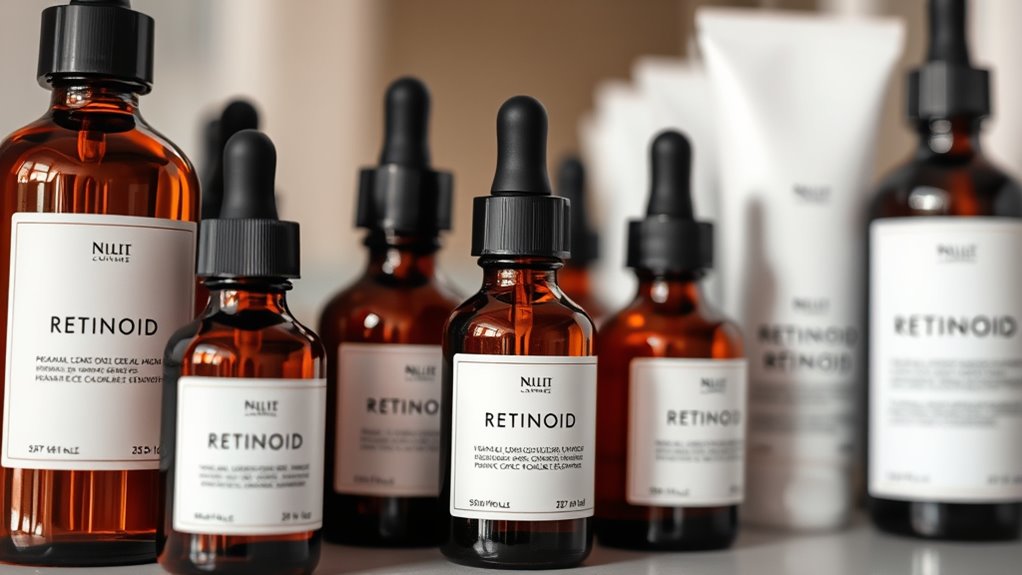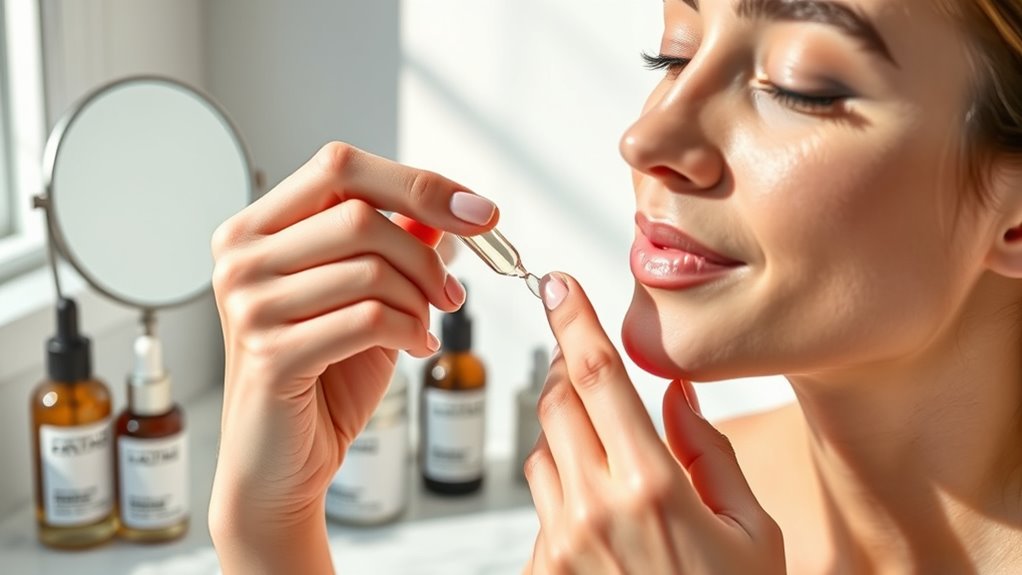Retinoids, derivatives of vitamin A, boost collagen, speed up skin cell renewal, and help reduce wrinkles, dark spots, and acne. They come in different forms like retinol, retinaldehyde, and tretinoin, suitable for various skin types and concerns. To use them safely, start with low concentrations, apply at night, and layer with moisturizer to minimize irritation. Consistent, proper use can transform your skin—continue to explore for more tips on maximizing their benefits.
Key Takeaways
- Retinoids are vitamin A derivatives that boost collagen, improve skin texture, and reduce signs of aging and acne.
- Start with low concentrations, apply 2-3 times weekly, and layer with moisturizer to minimize irritation.
- Use retinoids at night and always apply sunscreen during the day due to increased sun sensitivity.
- Gradually increase retinoid strength as your skin builds tolerance for optimal results.
- Proper layering, barrier support, and avoiding harsh products enhance safety and effectiveness.
What Are Retinoids and How Do They Work?

Have you ever wondered how some skincare products effectively reduce wrinkles and improve skin texture? It all starts with understanding retinoids. Their history dates back to the 1940s when researchers discovered their powerful effects on skin cell growth. Retinoid chemistry involves derivatives of vitamin A, which interact with skin cells to promote renewal. When applied, retinoids penetrate the skin and bind to specific receptors in the cell nucleus, influencing gene expression. This process accelerates collagen production and speeds up cell turnover, leading to smoother, more youthful skin. Over time, retinoids help diminish fine lines and improve skin texture. Their effectiveness relies on their ability to target the root causes of aging, making them a cornerstone of many skincare routines. Additionally, advancements in projector technology have improved how visual content is displayed, much like how retinoids improve skin at a cellular level. Recognizing the biological mechanisms behind retinoids can help users better understand their remarkable benefits.
Key Benefits of Incorporating Retinoids Into Your Skincare Routine

Incorporating retinoids into your skincare routine offers a range of powerful benefits that can transform your skin. They boost cell turnover, helping to fade wrinkles, fine lines, and dark spots, resulting in a smoother, more youthful look. Retinoids also unclog pores, reducing acne and preventing future breakouts. While some retinoid myths suggest they’re too harsh or only for aging skin, many find them effective and safe when used correctly. If you’re concerned about irritation, natural alternatives like bakuchiol can provide similar benefits without the side effects. Overall, retinoids help improve skin texture, tone, and elasticity, making them a valuable addition to your skincare arsenal. Consistent use yields visible improvements, giving you healthier, more radiant skin over time.
Different Types of Retinoids: Which One Is Right for You?

With so many retinoid options available, choosing the right one can feel overwhelming. Your decision depends on factors like retinoid potency and skincare compatibility. Here are four common types:
- Retinol – Mild yet effective, ideal for beginners with sensitive skin.
- Retinaldehyde – Slightly stronger than retinol, offering faster results with good compatibility.
- Adapalene – A targeted, prescription-strength option effective for acne-prone skin.
- Tretinoin – The most potent, best suited for experienced users and specific skin concerns.
Consider your skin’s sensitivity and goals when selecting a retinoid. Starting with a lower potency helps minimize irritation and guarantees better skincare compatibility as your skin adapts. Additionally, understanding the different types of retinoids can help you choose the most suitable option for your needs, especially when considering their potency levels and how they interact with various skin types. Recognizing the skincare compatibility of each retinoid can aid in preventing adverse reactions and optimizing results. Moreover, selecting a retinoid that aligns with your skin concerns ensures more effective and targeted treatment.
How to Properly Introduce Retinoids to Your Skin

When starting retinoids, begin slowly and increase use gradually to avoid irritation. Make sure to choose a formulation suited to your skin type for better results. Always layer a moisturizer over retinoids to protect your skin and reduce dryness. Incorporating knowledge about proper application techniques can enhance your overall skin health and prevent adverse reactions. A proper application technique is crucial for maximizing benefits and minimizing side effects. Additionally, staying informed about skin sensitivities can help tailor your routine to avoid unnecessary discomfort. Being aware of product ingredients can also help prevent allergic reactions and skin irritation.
Start Slowly and Gradually
To minimize irritation and guarantee your skin adapts smoothly, start with a low concentration of retinoids and apply them less frequently at first. Many beginners fall for retinoid myths and misconceptions, thinking immediate results are normal. To avoid this, follow these tips:
- Use retinoids 2-3 times a week initially.
- Apply a pea-sized amount to clean, dry skin.
- Always follow with moisturizer to reduce dryness.
- Be patient—visible results take time, and overuse can cause setbacks.
- Educate yourself about retinoid safety to ensure proper and effective use. Incorporating knowledge of dermatological recommendations can further enhance your skincare routine and minimize potential adverse effects. Additionally, understanding personal finance management can help you budget for quality skincare products and dermatologist consultations. Being aware of glycolic acid benefits can also support your skincare goals by promoting skin renewal and improving texture.
Choose the Right Formulation
Choosing the right formulation of retinoids is essential for a successful and comfortable introduction to these powerful skincare ingredients. You need to take into account formulation compatibility with your skin type, as some forms, like creams or serums, may be gentler than stronger alternatives. Pay attention to ingredient concentration; starting with a lower concentration helps minimize irritation and allows your skin to build tolerance gradually. If you’re new to retinoids, look for products labeled as “beginner” or “low strength,” and avoid high-potency options initially. Always read the label carefully to ensure the formulation suits your skin’s needs. Additionally, selecting a formulation with diverse design options can help enhance your overall skincare routine and make the process more enjoyable. Properly inflating Presta valve tires can also be crucial for maintaining your bike’s performance and safety during your routines. By selecting a formulation suited to your skin and concentration level, you set a solid foundation for effective and comfortable retinoid use.
Layer With Moisturizer
Layering your retinoid with moisturizer is a key step to minimize irritation and enhance your skin’s tolerance. Proper product layering provides layer protection, helping your skin adapt more comfortably. To do this effectively:
- Apply a small amount of retinoid evenly to clean, dry skin.
- Wait a few minutes to let it absorb.
- Lightly massage a moisturizer over the retinoid, creating a barrier.
- Adjust the moisturizer amount based on your skin’s response, adding more if needed.
- Using a pimple patch on blemishes can further protect your skin while introducing retinoids. Incorporating skin barrier reinforcement techniques can also support your skin’s resilience during retinoid use. Additionally, managing skin sensitivity by choosing gentle, fragrance-free products can further reduce irritation. Implementing proper product layering techniques can optimize retinoid benefits and minimize adverse effects. This method reduces potential redness and dryness, making retinoid use sustainable. Remember, product layering isn’t just about applying products; it’s about protecting your skin while maximizing benefits. Consistent layering with moisturizer helps your skin build tolerance and supports healthier, more resilient skin over time.
Common Side Effects and How to Minimize Them

While retinoids are highly effective for improving skin texture and clarity, they can also cause some common side effects that might concern you. The most frequent issues are retinoid irritation and skin dryness. To minimize these, start with a lower concentration and gradually increase usage as your skin builds tolerance. Always apply a gentle, hydrating moisturizer afterward to combat dryness and soothe irritation. Avoid using retinoids on broken or irritated skin, and limit exposure to harsh cleansers or exfoliants during treatment. Using sunscreen daily is essential, as retinoids can make your skin more sensitive to the sun. If irritation persists, consider spacing out applications or consulting a dermatologist for tailored advice. Public reactions often fuel ongoing discourse on infidelity, highlighting the importance of trust and communication in relationships. Incorporating AI-powered skincare tools that analyze your skin can help you customize your retinoid routine and reduce adverse effects. Additionally, understanding skincare ingredient interactions can help prevent unexpected reactions and optimize your treatment. These precautions can help you enjoy the benefits while minimizing side effects.
Tips for Maximizing Results and Ensuring Safe Use

To maximize your results and use retinoids safely, it’s important to introduce them gradually into your skincare routine. Start with a small amount and increase usage as your skin adjusts. Ensuring ingredient compatibility is key—avoid combining retinoids with harsh or irritating products. Here are four tips to help you get the most out of retinoids:
- Begin with a lower concentration to reduce irritation.
- Use retinoids at night to minimize sun sensitivity.
- Always apply a moisturizer afterward to prevent dryness.
- Be patient; visible improvements take consistent, long-term use.
- Proper beneficiary designation and understanding of inheritance rules can help prevent unexpected complications if you plan to incorporate your skincare assets into an estate plan.
Following these steps will help you optimize your skincare routine, maximize benefits, and keep your skin safe from adverse reactions.
Frequently Asked Questions
Can Retinoids Be Used Alongside Other Active Skincare Ingredients?
When combining retinoids with other active skincare ingredients, you should be cautious about ingredient interactions. Some ingredients, like acids or vitamin C, can cause irritation or reduce retinoids’ effectiveness. It’s best to introduce new products gradually and consult your dermatologist. Use retinoids at night and other active ingredients in the morning, or on alternate days, to minimize irritation and maximize benefits.
How Long Does It Typically Take to See Visible Results From Retinoids?
You might worry about how long it takes to see visible improvements with retinoids, but patience pays off. Typically, you’ll notice initial changes like smoother skin within 4 to 6 weeks. Full results, such as reduced fine lines and improved tone, usually appear after 12 weeks. Keep in mind, everyone’s timeline expectations vary, so stay consistent with your routine and give your skin time to adjust.
Are Retinoids Safe for Sensitive or Acne-Prone Skin?
You might wonder if retinoids are safe for sensitive or acne-prone skin. With gentle formulations, retinoids can be suitable, but it is crucial to start slow to minimize skin sensitivity. Always patch test first, and choose products designed for sensitive skin. Gradually increase usage as your skin tolerates, and consult a dermatologist if you experience irritation. Proper use helps you enjoy retinoids’ benefits without compromising your skin’s health.
What Should I Do if I Experience Severe Irritation?
If you experience severe irritation, stop using the retinoid immediately and adjust your skincare routines. Incorporate gentle, hydrating products to soothe your skin and consider reducing application frequency. Use a broad-spectrum sunscreen daily to protect your skin from sun sensitivity. If irritation persists, consult a dermatologist for personalized irritation management advice. Remember, patience is key—allow your skin time to recover before gradually reintroducing retinoids.
Can Pregnant or Breastfeeding Women Use Retinoids Safely?
Think of walking a tightrope—using retinoids during pregnancy and breastfeeding requires balance. You should know that most retinoids aren’t considered safe for pregnancy safety and breastfeeding considerations, as they can cause birth defects or harm your baby. Always consult your healthcare provider before starting any retinoid treatment. They can guide you on safe alternatives, ensuring you protect your health and your little one while maintaining your skincare routine.
Conclusion
By understanding retinoids and using them correctly, you can unlock radiant, youthful skin that rivals the glow of a thousand sunsets. Stick to the tips, start slow, and be patient—your skin’s transformation will be worth every effort. Remember, consistent use is your secret weapon against aging and blemishes, turning your skincare routine into a powerful, almost magical tool. Embrace retinoids, and watch your skin become your most stunning masterpiece yet.










